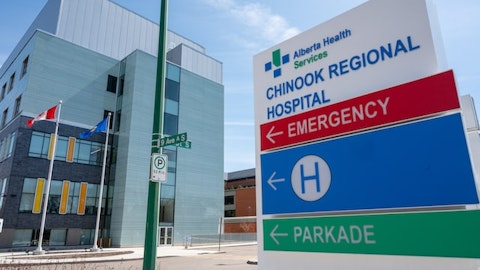George Farmer: Just wondering if you could go into some detail about what the diagnostic criteria are going to be in order for pre auth to get approved. It seems to me it was such an expensive drug that one would want to differentiate, say, from just general baby blues to follow-on diagnostic — diagnosed PPD. Can you speak to that?
Barry Greene: Yes. Let me start and I’ll ask Laura and if Chris has more color to add, Chris comment on that. So let me start with, George, I think, as we said at the beginning of the call, we and Biogen were deliberate and thoughtful when determining the wholesale acquisition cost for ZURZUVAE. And I actually believe that we’re adding value to the health care system. We will publish the relative cost-effectiveness of ZURZUVAE versus what’s being used today, SSRIs, and others, which, as you heard Laura talked about, takes weeks to months to work and the societal cost of un or undertreated PPD on the mom and baby very, very significant. So we actually think that the way we position the wholesale acquisition cost is adding value to the health care system, not “expensive.” In terms of how to diagnose, let me ask Laura to talk about how we believe the various health care providers will diagnose and then attest to that diagnosis.
Laura Gault: Sure. Thanks, Barry. So I know when people think about PPD, they think about the baby blues as well. And the baby blues is a real thing. It happens in about 80% of pregnancies in the first week or so following delivery. But the presentation of the baby blues is very, very different from the presentation of postpartum depression. In baby blues, people might be a little weepy, they might have some changes in mood, might be a little anxious. But that lasts only a few days and it results. With postpartum depression, the magnitude of these symptoms, the severity is much higher and it lasts for a much longer time. And it really interferes with the ability of the mom to take care of her baby and to take care of the other children and the family.
It has real functional consequences. And so the differences between these 2 are really abundantly obvious to people who are used to treating women in the postpartum period. And I don’t think that these will be confused. As a consequence, I believe that payers are also going to recognize that clinicians are appropriately diagnosing the patients who will benefit from treatment.
Barry Greene: Yes. Chris, do you want to order on how we think, where we have prior auth, they might work?
Christopher Benecchi: Yes. So to talk about prior authorization, Barry, and let me take a step back and just say that based on the fair feedback state, we don’t anticipate complex prior authorization associated with the prescription of ZURZUVAE. In effect, what we would anticipate is that if there is any prior authorization, it would be a checkbox PA around something like the patient having a diagnosis of postpartum depression from her clinician. That’s really the feedback that we’re getting at this point to-date.
George Farmer: So it will be just as simple as that, just to check the box diagnosis?
Barry Greene: Yes, George, that’s what we’re working towards. I mean, it’s a sole indication. So if prescriptions go in, there’d be a potential electronic question back, please confirm this is PPD, without a whole bunch of other heavy diagnostics. Again, the payer system understands the economic burden associated with an under or undiagnosed PPD and it’s extreme to that mom and the baby as well as the societal indication. So I think it’s very well understood.
Operator: We go next to the line of Sumant Kulkarni with Canaccord.
Sumant Kulkarni: It’s nice to see that ZURZUVAE will be able available for patients in the near future here. So we went through the review documents for ZURZUVAE and we’re looking specifically at the post-marketing requirements and commitments. Do you expect these studies, especially the nonclinical safety study to have the potential to make any adjustments in the language of the label as it stands today? And would those have any bearing on your potential ability to still pursue zuranolone for major depressive disorder?
Barry Greene: Hey Sumant, thanks. So let me start and I can turn it over to Laura. So as you are, we’re very excited after all this time to make ZURZUVAE commercially available to those suffering from postpartum depression. We’re really looking forward to getting out there and helping as many women as we possibly can. In terms of our focus, as I mentioned on the call, we’re very, very focused on the successful launch of ZURZUVAE for PPD. As I commented on, if there are any other indications that come into the label or revise in making any definitive determinations, we’ll certainly let you know. But I think everybody should be solely focused on ZURZUVAE for PPD for the foreseeable future. Laura, do you want to talk about — they’re not very significant, the post-marketing requirements you have?
Laura Gault: Sure. So we received 2 post-marketing requests on the approval of ZURZUVAE for PPD. One is to conduct an embryofetotoxicity study in a second species and the other is to understand the PK safety and tolerability of ZURZUVAE in females aged 16 to 80. So each of these studies is in the process of being conducted. When we have the data, we will approach the agency and share that data with them. And we will have a discussion with them about whether changes to the label are warranted based on these new data.
Barry Greene: We certainly anticipate the 14 — the 16-year-old plus data as we did with ZULRESSO being something that is a labeling change in activity. Were there anything else is to be determined.
Operator: We go next to the line of Laura Chico with Wedbush Securities.
Laura Chico: Just referencing ZULRESSO. I’m wondering if you could kind of circle back to that time line between writing a script and getting it issued for ZURZUVAE. And just remind us, what did that kind of evolution look like over the course of ZULRESSO’s time on the market? Were you able to condense that down? And any learnings there in terms of how it might help with ZURZUVAE?
Barry Greene: Yes, let me take that. So in terms of — let’s start with ZULRESSO. In terms of ZULRESSO, if a health care provider does a definitive diagnosis on PPD, start [indiscernible] because ZULRESSO requires a infusion site and then a lot of logistical support. It could be flights, caring of children. The fact that we had such an increase — and the numbers were small, but such an increase from the beginning of ZULRESSO to last quarter, almost a three or fourfold increase in the number of women we’re helping really shows the unmet need and the desire to treat given all the logistical challenges. With ZURZUVAE, it’s an oral treatment that comes in 8 pack as we showed on our slides during the call, and it works like any other script that will flow through specialty pharma.



